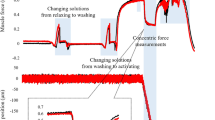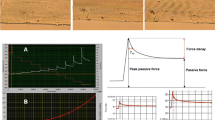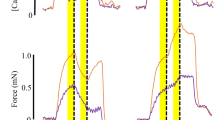Abstract
The origins of the smaller age-related decrease in eccentric force compared to isometric and concentric conditions in vivo remain unclear. Could this originate from contractile elements of muscle cells? The main intent of the current investigation was to assess the force behavior of muscle cells with aging, during lengthening. Chemically skinned single muscle fibers (n=235) from m. vastus lateralis of six young (mean age 31.6 years) and six older men (mean age 66.1 years) were maximally activated with pCa 4.5 at 15°C. Maximal isometric force and cross-sectional area were measured allowing the calculation of the tension (T 0). A quick stretch (2 nm per half-sarcomere length) was applied and caused an immediate increase in tension followed by a decrease and a secondary delayed and transient rise in tension (phase 3); finally, the tension recovered a steady state value (phase 4). The tension enhancements during phase 3 (ΔT 3) and phase 4 (ΔT 4) were evaluated. The myosin heavy-chain isoform composition of each single fiber was determined by sodium dodecyl sulfate-polyacrylamide gel electrophoresis. ΔT 3 and ΔT 4 were preserved in older men for both type I and IIa fibers despite a reduction in T 0. Therefore, the age-related preservation of the tension increments after a quick stretch in single muscle fibers could explain in part the smaller decrease in force during eccentric contractions compared to isometric and concentric conditions in vivo with aging usually observed.


Similar content being viewed by others
References
Alnaqueeb MA, Goldspink G (1986) Changes in fiber type number and diameter in developing and aging skeletal muscle. J Anat 153:31–45
Andruchov O, Andruchova O, Wang Y, Galler S (2005) Kinetic properties of myosin heavy chain isoforms in mouse skeletal muscle: comparison with rat, rabbit, and human and correlation with amino acid sequence. Am J Physiol Cell Physiol 287:1725–1732
Bagni MA, Cecchi G, Colomo F, Poggesi C (1990) Tension and stiffness of frog muscle fibres at full filament overlap. J Muscle Res Cell Motil 11:371–377
Bergstrom J (1962) Muscle electrolytes in man. Scand J Clin Lab Invest 14(Suppl 68):1–110
D’Antona G, Pellegrino MA, Adami R, Rossi R, Carlizzi CN, Canepari M, Saltin B, Bottinelli R (2003) The effect of ageing and immobilization on structure and function of human skeletal muscle fibres. J Physiol 552:499–511
Doherty TJ (2003) Invited review: aging and sarcopenia. J Appl Physiol 95:1717–1727
Evans WJ, Phinney SD, Young VR (1982) Suction applied to a muscle biopsy maximizes sample size. Med Sci Sports Exerc 14:101–102
Fabiato A (1988) Computer programs for calculating total from specified free or free from specified total ionic concentrations in aqueous solutions containing multiple metals and ligands. Methods Enzymol 157:378–417
Frontera WR, Suh D, Krivickas LS, Hughes VA, Goldstein R, Roubenoff R (2000) Skeletal muscle fibre quality in older men and women. Am J Physiol Cell Physiol 279:611–618
Galler S, Schmitt T, Hilber K, Pette D (1997) Stretch activation and isoforms of myosin heavy chain and troponin T of rat skeletal muscle fibres. J Muscle Res Cell Motil 18:555–561
Hilber K, Galler S, Gohlsch B, Pette D (1999) Kinetic properties of myosin heavy chain isoforms in single fibers from human skeletal muscle. FEBS Lett 455:267–270
Hortobagyi T, Zheng D, Weidner M, Lambert N, Westbrook S, Houmard JA (1995) The influence of aging on muscle strength and muscle fiber characteristics with special reference to eccentric strength. J Gerontol A Biol Sci Med Sci 6:399–406
Huxley AF, Simmons RM (1971) Proposed mechanism of force generation in striated muscle. Nature 233:533–538
Kent-Braun JA, Ng VA, Young K (2000) Skeletal muscle contractile and non contractile components in young and older women and men. J Appl Physiol 88:662–668
Klass M, Baudry S, Duchateau J (2005) Aging does not affect voluntary activation of the ankle dorsiflexors during isometric, concentric, and eccentric contractions. J Appl Physiol 99:31–38
Krivickas LS, Suh D, Wilkins J, Hughes VA, Roubenoff R, Frontera WR (2001) Age- and gender-related differences in maximum shortening velocity of skeletal muscle fibres. Am J Phys Med Rehabil 80:447–455
Larsson L, Moss RL (1993) Maximum velocity of shortening in relation to myosin isoform composition in single fibres from human skeletal muscles. J Physiol 472:595–614
Larsson L, Li X, Yu F, Degens H (1997) Age-related changes in contractile properties and expression of myosin isoforms in single skeletal muscle cells. Muscle Nerve 5:74–78
Lexell J, Downham DY (1991) The occurrence of fibre-type grouping in healthy human muscle: a quantitative study of cross-sections of whole vastus lateralis from men between the age of 15 and 83 years. Acta Neuropathol (Berl) 81:377–381
Linari M, Reedy MK, Reedy MC, Lombardi V, Piazzesi G (2004) Ca-activation and stretch-activation in insect flight muscle. Biophys J 87:1101–1111
Linari M, Bottinelli R, Pellegrino MA, Reconditi M, Reggiani C, Lombardi V (2004) The mechanism of the force response to stretch in human skinned muscle fibres with different myosin isoforms. J Physiol 554:335–352
Liu J, Reedy MC, Goldman YE, Franzini-Armstrong C, Sasaki H, Tregear RT, Lucaveche C, Winkler H, Baumann BA, Squire JM, Irving TC, Reedy MK, Taylor KA (2004) Electron tomography of fast frozen, stretched rigor fibers reveals elastic distortions in the myosin crossbridges. J Struct Biol 147:268–282
Lowe DA, Surek JT, Thomas DD, Thompson LV (2001) Electron paramagnetic resonance reveals age-related myosin structural changes in rat skeletal muscle fibres. Am J Physiol Cell Physiol 280:540–547
Macaluso A, De Vito G (2004) Muscle strength, power and adaptations to resistance training in older people. Eur J Appl Physiol 91:450–472
Moss RL (1979) Sarcomere length–tension relations of frog skinned muscle fibres during calcium activation at short lengths. J Physiol 292:177–192
Porter MM, Vandervoort AA, Lexell J (1995) Aging of human muscle: structure, function and adaptability. Scand J Med Sci Sports 5:129–142
Porter MM, Vandervoort AA, Kramer JF (1997) Eccentric peak torque of plantar and dorsiflexors is maintained in older women. J Gerontol A Biol Sci Med Sci 52:125–131
Pousson M, Lepers R, Van Hoecke J (2001) Changes in isokinetic torque and muscular activity of elbow flexors muscles with age. Exp Gerontol 36:1687–1698
Rassier DE, Herzog W (2005) Relationship between force and stiffness in muscle fibers after stretch. J Appl Physiol 99:1769–1775
Rice CL, Cunningham DA, Paterson D, Lefcoe MS (1989) Arm and leg composition determined by computed tomography in young and elderly men. Clin Physiol 9:207–220
Roos MR, Rice CL, Connelly DM, Vandervoort AA (1999) Quadriceps muscle strength, contractile properties, and motor unit firing rates in young and old men. Muscle Nerve 22:1094–1103
Trappe S, Gallagher P, Harber M, Carrithers J, Fluckey J, Trappe T (2003) Single muscle fibre contractile properties in young and old men and women. J Physiol 552:47–58
Vandervoort AA, Kramer JF, Wharram ER (1990) Eccentric knee strength of elderly females. J Gerontol 45:125–128
White DC (1983) The elasticity of relaxed insect fibrillar flight muscle. J Physiol 343:31–57
Wood DS, Zollman J, Reuben JP (1975) Human skeletal muscle: properties of the “chemically skinned” fiber. Science 187:1075–1076
Acknowledgements
The authors gratefully acknowledge Dr. Stefan Galler (Department of Cell Biology, University of Salzburg, Austria) for his valuable suggestions in refining the methods. The authors also wish to thank Gomathi Krishnan and Andreas Johansson for their valuable help with experiments. This work was supported by grants from the National Institute of Health (#AG18844-01).
Author information
Authors and Affiliations
Corresponding author
Additional information
An erratum to this article can be found at http://dx.doi.org/10.1007/s00424-006-0167-1
Rights and permissions
About this article
Cite this article
Ochala, J., Dorer, D.J., Frontera, W.R. et al. Single skeletal muscle fiber behavior after a quick stretch in young and older men: a possible explanation of the relative preservation of eccentric force in old age. Pflugers Arch - Eur J Physiol 452, 464–470 (2006). https://doi.org/10.1007/s00424-006-0065-6
Received:
Revised:
Accepted:
Published:
Issue Date:
DOI: https://doi.org/10.1007/s00424-006-0065-6




